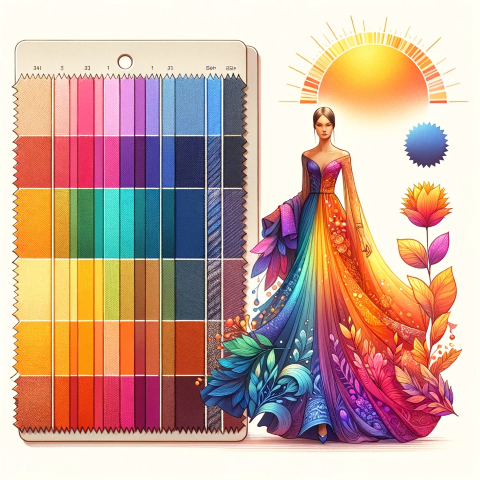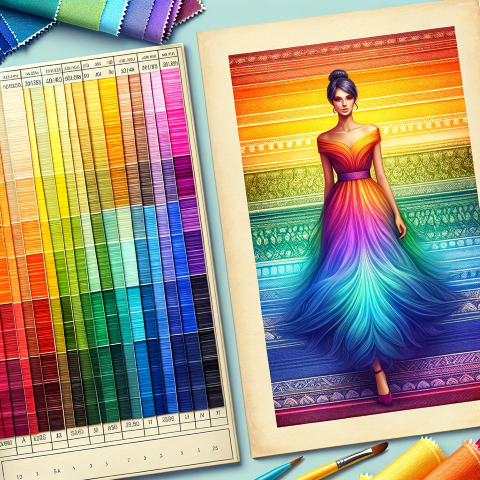Last Updated on: 02-Apr-2024 (3 months, 25 days ago)
Share on Facebook • Share on Twitter
Hue can be used to describe a color's position on the color spectrum, and different hues can evoke different emotional responses. For example, red hues are often associated with passion and excitement, while blue hues are associated with calmness and tranquility. In the textile industry, hue is a critical factor in color matching and is used extensively in color theory and color management.
In textile production, hue is achieved through the use of colorants, including natural dyes, synthetic dyes, and pigments. Natural dyes are obtained from plants, animals, and minerals and can produce a wide range of hues, from muted earth tones to bright, vibrant colors. Synthetic dyes, on the other hand, are chemically synthesized and can produce hues that are not found in nature. Pigments are insoluble colorants that are used in printing and can produce opaque and intense hues.
Hue is an essential consideration in textile design and fashion, where designers often use color to convey a particular mood or message. Fashion designers use hues to create collections that evoke a specific emotional response from the consumer. They may choose to use different hues to convey different moods, such as bright and bold hues for a playful and energetic collection, or muted and subdued hues for a more sophisticated and elegant look.
In the textile industry, hue is also an essential consideration for color matching. Color matching is the process of ensuring that the colors of a textile product match the colors of the original design or sample. Color matching is critical in producing consistent and high-quality textile products, as slight variations in hue can result in a product that looks different from the original design.
There are several methods for measuring hue in the textile industry. One common method is to use a spectrophotometer, which measures the spectral reflectance of the textile sample and calculates the hue using mathematical algorithms. Another method is to use a colorimeter, which measures the color of a textile sample using color filters and light sensors.
The hue of textile products can also be affected by external factors such as lighting conditions. Different lighting conditions can alter the perception of hue, making it essential to evaluate the hue of textile products under standard lighting conditions.
In terms of top users or manufacturers, the textile industry as a whole relies heavily on the concept of hue. This is because the color of a textile product is one of the most critical factors in determining its aesthetic appeal and marketability. Textile manufacturers and fashion designers alike must consider hue when creating new products, ensuring that the color matches their vision and will resonate with their target audience.
Some of the top manufacturers in the textile industry include Cotton Incorporated, DuPont, and Lenzing AG. These companies produce a wide range of textile products, including fabrics, fibers, and yarns, and often invest heavily in research and development to improve the performance and aesthetic qualities of their products.
In terms of top users of textile products, the fashion industry is one of the most significant. Fashion designers use textiles to create garments and accessories that are both functional and aesthetically appealing. The fashion industry is highly competitive, and designers must stay on top of the latest trends and innovations to remain relevant and successful.
In conclusion, hue is a critical concept in the textile industry. It refers to the purest form of a color and is used extensively in color theory, color management, and textile design. Hue is achieved through the use of colorants such as natural dyes, synthetic dyes, and pigments,
The specific color classification given to an object based on the seven colors found in the spectrum; red, orange yellow, green, blue, indigo, or violet. For example, garnets are found in a variety of shades of red from pink to plum, but all of these shades fall under the "hue" of "red". The more internally consistent a stone's hue is, the more valuable the stone is considered to be.
Some more terms:
UPF
(Ultraviolet Protection Factor) The UPF rating indicates how effective a fabric is at blocking out solar ultraviolet radiation from reaching the skin. UPF ratings range from 15 to 50 with higher...
Read about UPFPiece Dyeing: The Transformative Process Shaping Textile Trends
Piece Dyeing: An Integral Textile Coloring TechniqueTextiles have been dyed since ancient times, with the earliest records dating back to the Neolithic period. Dyeing, as an art and science, has...
Read about Piece DyeingHigh Cut Rio
A panty style similar to the string bikini, but with moderate back coverage that looks more like a "v" instead of the "u" which is found in full coverage backs. Many times, the waistband in the...
Read about High Cut RioDonegal Tweed
A medium to heavy of plain or twill weave fabric in which colorful yarn slubs are woven into the fabric. Made from wool but can also be made from rayons and cottons. It is mostly made from a plain...
Read about Donegal TweedWicking
Refers to the ability of a fabric to move moisture (sweat) away from the skin to the outer layer of fabric where it can evaporate more easily thus helping to keep the skin dry. Used in activewear and...
Read about WickingPush-pull Fabrics
Push-pull fabrics, also known as dual-action fabrics, are a type of textile engineered with unique properties that enable them to effectively manage moisture and enhance comfort in various...
Read about Push-pull FabricsVinyon
A synthetic fiber polymer made from polyvinyl chloride. In some countries other than the United States, vinyon fibers are referred to as polyvinyl chloride fibers and is similar in nature to vinyl....
Read about VinyonAbrasive Fabrics
A general term for cotton fabrics used as backings for various abrasive and polishing agents. Usually sheetings and drills are employed extensively and twills in smaller quantities. The fabric is...
Read about Abrasive FabricsAdd a definition
- The term you want to define
- Its definition in 500 words or less
- Attach an image if necessary.
- Optionally, tell us about yourself in 200 words or less!
Companies for Hue:
- Company name
- Company address
- Attach a logo, if necessary.
- Optionally, tell us about yourself in 200 words or less!

 The city of Iksan is known for its vibrant textile and garment industry.
The city of Iksan is known for its vibrant textile and garment industry.

